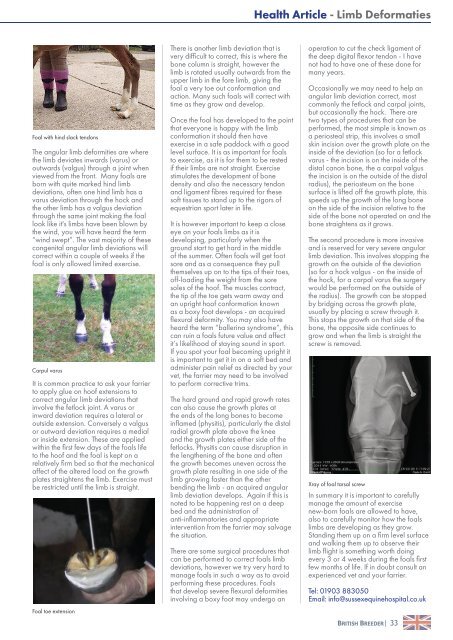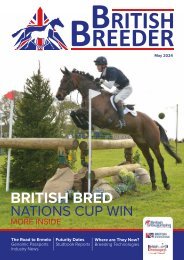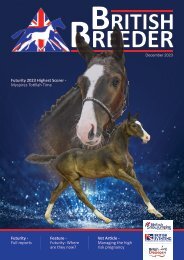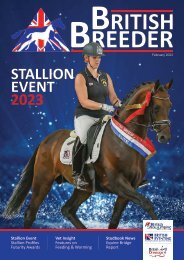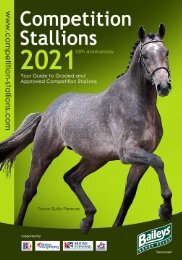British Breeder May 2023
The British Breeder is the magazine for all those interested and breeding sports horses. The latest news for the British Studbooks alongside features on dam lines, stallions, veterinary articles, nutrition, farrier and anything related to the breeding of sports horses.
The British Breeder is the magazine for all those interested and breeding sports horses. The latest news for the British Studbooks alongside features on dam lines, stallions, veterinary articles, nutrition, farrier and anything related to the breeding of sports horses.
You also want an ePaper? Increase the reach of your titles
YUMPU automatically turns print PDFs into web optimized ePapers that Google loves.
Health Article - Limb Deformaties<br />
Foal with hind slack tendons<br />
The angular limb deformities are where<br />
the limb deviates inwards (varus) or<br />
outwards (valgus) through a joint when<br />
viewed from the front. Many foals are<br />
born with quite marked hind limb<br />
deviations, often one hind limb has a<br />
varus deviation through the hock and<br />
the other limb has a valgus deviation<br />
through the same joint making the foal<br />
look like it's limbs have been blown by<br />
the wind, you will have heard the term<br />
“wind swept”. The vast majority of these<br />
congenital angular limb deviations will<br />
correct within a couple of weeks if the<br />
foal is only allowed limited exercise.<br />
Carpul varus<br />
It is common practice to ask your farrier<br />
to apply glue on hoof extensions to<br />
correct angular limb deviations that<br />
involve the fetlock joint. A varus or<br />
inward deviation requires a lateral or<br />
outside extension. Conversely a valgus<br />
or outward deviation requires a medial<br />
or inside extension. These are applied<br />
within the first few days of the foals life<br />
to the hoof and the foal is kept on a<br />
relatively firm bed so that the mechanical<br />
affect of the altered load on the growth<br />
plates straightens the limb. Exercise must<br />
be restricted until the limb is straight.<br />
Foal toe extension<br />
There is another limb deviation that is<br />
very difficult to correct, this is where the<br />
bone column is straight, however the<br />
limb is rotated usually outwards from the<br />
upper limb in the fore limb, giving the<br />
foal a very toe out conformation and<br />
action. Many such foals will correct with<br />
time as they grow and develop.<br />
Once the foal has developed to the point<br />
that everyone is happy with the limb<br />
conformation it should then have<br />
exercise in a safe paddock with a good<br />
level surface. It is as important for foals<br />
to exercise, as it is for them to be rested<br />
if their limbs are not straight. Exercise<br />
stimulates the development of bone<br />
density and also the necessary tendon<br />
and ligament fibres required for these<br />
soft tissues to stand up to the rigors of<br />
equestrian sport later in life.<br />
It is however important to keep a close<br />
eye on your foals limbs as it is<br />
developing, particularly when the<br />
ground start to get hard in the middle<br />
of the summer. Often foals will get foot<br />
sore and as a consequence they pull<br />
themselves up on to the tips of their toes,<br />
off-loading the weight from the sore<br />
soles of the hoof. The muscles contract,<br />
the tip of the toe gets warm away and<br />
an upright hoof conformation known<br />
as a boxy foot develops - an acquired<br />
flexural deformity. You may also have<br />
heard the term “ballerina syndrome”, this<br />
can ruin a foals future value and affect<br />
it’s likelihood of staying sound in sport.<br />
If you spot your foal becoming upright it<br />
is important to get it in on a soft bed and<br />
administer pain relief as directed by your<br />
vet, the farrier may need to be involved<br />
to perform corrective trims.<br />
The hard ground and rapid growth rates<br />
can also cause the growth plates at<br />
the ends of the long bones to become<br />
inflamed (physitis), particularly the distal<br />
radial growth plate above the knee<br />
and the growth plates either side of the<br />
fetlocks. Physitis can cause disruption in<br />
the lengthening of the bone and often<br />
the growth becomes uneven across the<br />
growth plate resulting in one side of the<br />
limb growing faster than the other<br />
bending the limb - an acquired angular<br />
limb deviation develops. Again if this is<br />
noted to be happening rest on a deep<br />
bed and the administration of<br />
anti-inflammatories and appropriate<br />
intervention from the farrier may salvage<br />
the situation.<br />
There are some surgical procedures that<br />
can be performed to correct foals limb<br />
deviations, however we try very hard to<br />
manage foals in such a way as to avoid<br />
performing these procedures. Foals<br />
that develop severe flexural deformities<br />
involving a boxy foot may undergo an<br />
operation to cut the check ligament of<br />
the deep digital flexor tendon - I have<br />
not had to have one of these done for<br />
many years.<br />
Occasionally we may need to help an<br />
angular limb deviation correct, most<br />
commonly the fetlock and carpal joints,<br />
but occasionally the hock. There are<br />
two types of procedures that can be<br />
performed, the most simple is known as<br />
a periosteal strip, this involves a small<br />
skin incision over the growth plate on the<br />
inside of the deviation (so for a fetlock<br />
varus - the incision is on the inside of the<br />
distal canon bone, the a carpal valgus<br />
the incision is on the outside of the distal<br />
radius), the periosteum on the bone<br />
surface is lifted off the growth plate, this<br />
speeds up the growth of the long bone<br />
on the side of the incision relative to the<br />
side of the bone not operated on and the<br />
bone straightens as it grows.<br />
The second procedure is more invasive<br />
and is reserved for very severe angular<br />
limb deviation. This involves stopping the<br />
growth on the outside of the deviation<br />
(so for a hock valgus - on the inside of<br />
the hock, for a carpal varus the surgery<br />
would be performed on the outside of<br />
the radius). The growth can be stopped<br />
by bridging across the growth plate,<br />
usually by placing a screw through it.<br />
This stops the growth on that side of the<br />
bone, the opposite side continues to<br />
grow and when the limb is straight the<br />
screw is removed.<br />
Xray of foal tarsal screw<br />
In summary it is important to carefully<br />
manage the amount of exercise<br />
new-born foals are allowed to have,<br />
also to carefully monitor how the foals<br />
limbs are developing as they grow.<br />
Standing them up on a firm level surface<br />
and walking them up to observe their<br />
limb flight is something worth doing<br />
every 3 or 4 weeks during the foals first<br />
few months of life. If in doubt consult an<br />
experienced vet and your farrier.<br />
Tel: 01903 883050<br />
Email: info@sussexequinehospital.co.uk<br />
BRITISH BREEDER| 33


